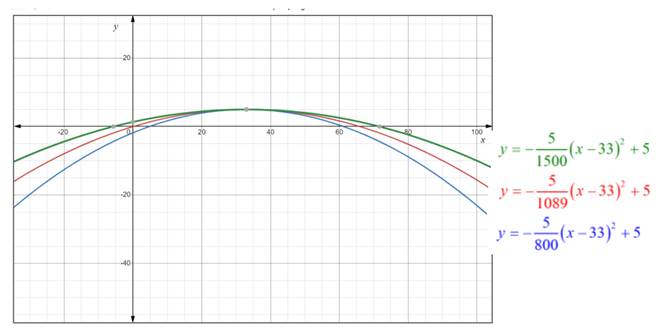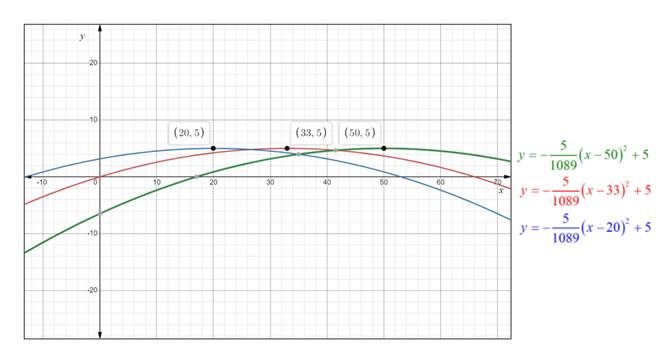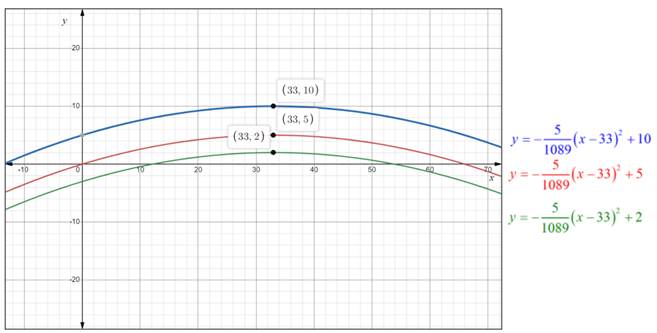
Concept explainers
To find: The quadratic function
The model for the flight path is
Given information:
The flying fish reaches a maximum height of 5 feet after flying for a horizontal distance of 33 feet.
Concept used:
Vertex form a quadratic function is given as
The vertex of the quadratic function represents the maximum/minimum point of the function.
If
Calculation:
Since flying fish reaches a maximum height of 5 feet after flying for a horizontal distance of 33 feet, the vertex of the quadratic function followed by the flying will be
The quadratic function with vertex at
Since the flying fish leaves the water level at the point
Substitute
Now, substitute
Effect of changing the value of
Draw the flight path for different values of

If the value of
If the value of
Effect of changing the value of
Draw the flight path for different values of

If the value of
If the value of
Effect of changing the value of
Draw the flight path for different values of

If the value of
If the value of
Conclusion:
The model for the flight path is
Chapter 1 Solutions
Algebra 2: New York Edition (holt Mcdougal Larson Algebra 2)
- 1. For the following subsets of R3, explain whether or not they are a subspace of R³. (a) (b) 1.1 0.65 U = span -3.4 0.23 0.4 -0.44 0 (})} a V {(2) | ER (c) Z= the points in the z-axisarrow_forwardSolve the following equation forx. leave answer in Simplified radical form. 5x²-4x-3=6arrow_forwardMATCHING LIST Question 6 Listen Use the given equations and their discriminants to match them to the type and number of solutions. 00 ed two irrational solutions a. x²+10x-2=-24 two rational solutions b. 8x²+11x-3=7 one rational solution c. 3x²+2x+7=2 two non-real solutions d. x²+12x+45 = 9 DELL FLOWER CHILD 10/20 All Changes S $681 22991arrow_forward
- 88 MULTIPLE CHOICE Question 7 Listen The following irrational expression is given in unsimplified form with four op- tions in simplified form. Select the correct simplified form. Select only one option. A 2±3√√2 B 4±√3 2±√ √3 D 1±√√3 DELL FLOWER CHILD 11/200 4 ± √48 4 ✓ All Changes Saved 165arrow_forwardUse the graph of y = f(x) to answer the following. 3- 2 -4 -2 -1 1 2 3 4 -1 2 m -3- + (d) Find all x for which f(x) = -2. If there is more than one value, separate them with commas or write your answer in interval notation, if necessary. Select "None", if applicable. Value(s) of x for which f(x)=-2: | (0,0) (0,0) (0,0) (0,0) 0,0... -00 None (h) Determine the range of f. The range is (0,0) Garrow_forwardWhat is g(f(4))arrow_forward
- 10) Multiply (8m + 3)² A) 8m²+11m+6 B) m² + 48m+9 C) 64m²+48m+9 D) 16m²+11m+6arrow_forwardLet R be field and X= R³/s Vector space over R M=(a,b,c)labic, e Rra+b= 3- <3 Show that Ms and why with proof. 1) is convexset and affine set of botost ii) is blanced set and symmetirs set of x iii) is hy per space and hyper plane ofx or hot iii) find f:MR st kerf = M 18/103 and finnd fiM→R/{0} st M= {xEX, f(t) = x, texiαER? jiii) show that Mis Maxsubspace or not and Mis a max. affine set or not.arrow_forwardFind The partial fraction decomposition for each The following 2× B) (x+3) a 3 6 X-3x+2x-6arrow_forward
- 1) Find the partial feraction decomposition for each of 5- X 2 2x+x-1 The following: 3 B) 3 X + 3xarrow_forwardT={(−7,1),(1,−1),(6,−8),(2,8)} Find the domain and range of the inverse. Express your answer as a set of numbers.arrow_forwardT={(−7,1),(1,−1),(6,−8),(2,8)}. Find the inverse. Express your answer as a set of ordered pairs.arrow_forward
 Algebra and Trigonometry (6th Edition)AlgebraISBN:9780134463216Author:Robert F. BlitzerPublisher:PEARSON
Algebra and Trigonometry (6th Edition)AlgebraISBN:9780134463216Author:Robert F. BlitzerPublisher:PEARSON Contemporary Abstract AlgebraAlgebraISBN:9781305657960Author:Joseph GallianPublisher:Cengage Learning
Contemporary Abstract AlgebraAlgebraISBN:9781305657960Author:Joseph GallianPublisher:Cengage Learning Linear Algebra: A Modern IntroductionAlgebraISBN:9781285463247Author:David PoolePublisher:Cengage Learning
Linear Algebra: A Modern IntroductionAlgebraISBN:9781285463247Author:David PoolePublisher:Cengage Learning Algebra And Trigonometry (11th Edition)AlgebraISBN:9780135163078Author:Michael SullivanPublisher:PEARSON
Algebra And Trigonometry (11th Edition)AlgebraISBN:9780135163078Author:Michael SullivanPublisher:PEARSON Introduction to Linear Algebra, Fifth EditionAlgebraISBN:9780980232776Author:Gilbert StrangPublisher:Wellesley-Cambridge Press
Introduction to Linear Algebra, Fifth EditionAlgebraISBN:9780980232776Author:Gilbert StrangPublisher:Wellesley-Cambridge Press College Algebra (Collegiate Math)AlgebraISBN:9780077836344Author:Julie Miller, Donna GerkenPublisher:McGraw-Hill Education
College Algebra (Collegiate Math)AlgebraISBN:9780077836344Author:Julie Miller, Donna GerkenPublisher:McGraw-Hill Education





